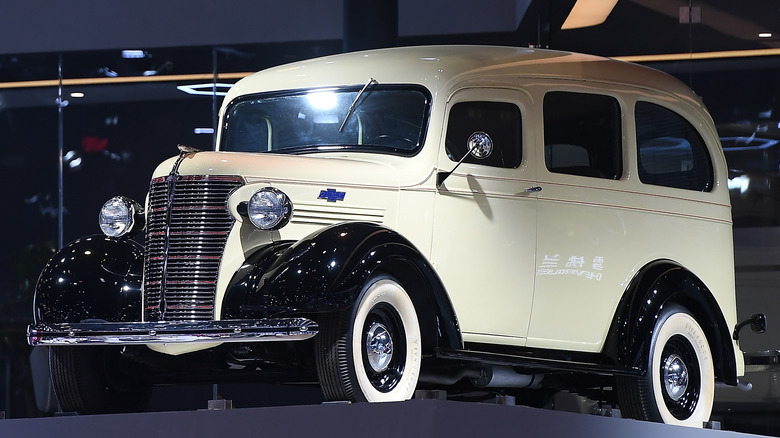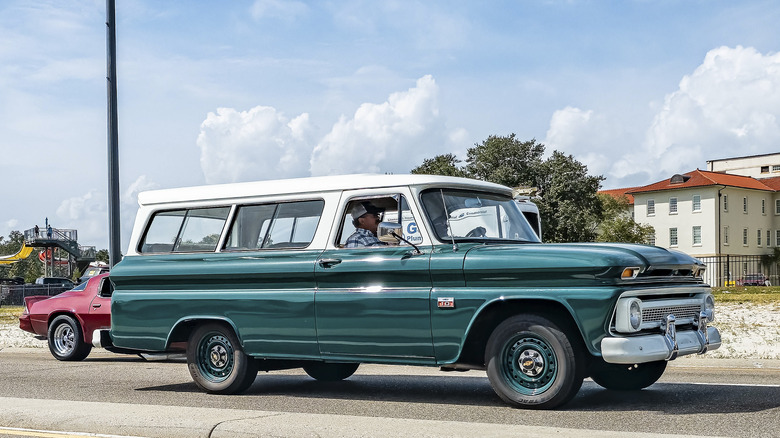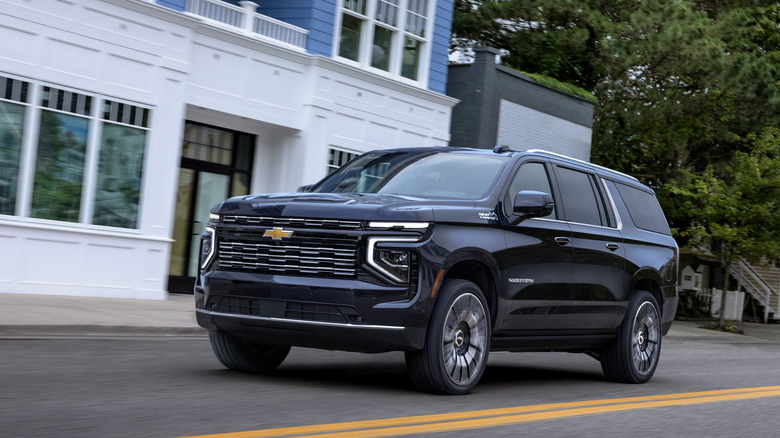The Longest-Produced Car Has Been Made For 90 Years
The title of longest continuously produced nameplate belongs to a GM favorite, the Chevrolet Suburban. The model officially dates back to 1935, although it's worth noting that third-party coachbuilders were building wagon bodies on truck frames with the Suburban name as early as 1926. It was a similar practice that actually led to the creation of the term "station wagon."
Marketed as the Carryall Suburban, Chevy's then-new model was an eight-passenger, three-row wagon built on a truck chassis. It wasn't the only model to sport the nameplate, with GMC launching its version in 1937. Truth be told, the nameplate was used by several automakers over the decades, including Plymouth, which marketed its station wagons under the name until 1978. However, Chevy officially secured the Suburban trademark in 1988, and GMC dropped the Suburban name after over 60 years, switching to "Yukon XL" in 2000.
Over its lifetime, the Suburban has served multiple roles, including as a family hauler, an ambulance, a VIP limousine, and a heavy-duty towing vehicle. Its endurance is reflected in its 13 generations, each one built on the same basic formula: A large, body-on-frame SUV derived from Chevrolet's full-size pickups, capable of moving people and cargo with truck-grade toughness.
Key moments from the Suburban story
The Suburban's first generation introduced the concept of a truck-based wagon for up to eight passengers — an idea that would truly stand the test of time. The model remained in constant production, even through the troubled years of World War II. The post-war fourth generation arrived in '47 and boasted significant changes, such as a large new grille and more power under the hood. The fifth-generation model, which arrived in '55, introduced a smart wraparound windshield, optional V8 engines, and four-wheel drive. All of these really broadened the Suburban's appeal, and sixth-gen models only improved on this by introducing independent front suspension and other niceties.
In 1967, the Suburban gained a longer 127-inch wheelbase and added a second passenger-side rear door, improving practicality. The eighth generation saw Chevy put a rear door on both sides, which brought about the now-familiar four-door layout. Technological advancements such as fuel injection and antilock brakes also came to the Suburban.
That eighth-gen model stayed in production for several decades, moving aside for the ninth generation in 1992. The Suburban gained a more aerodynamic look, with flush glass and aero-friendly headlights, as well as airbags and automatic all-wheel drive. The 10th-gen model updated styling further for the 21st century, and introduced Corvette-sourced V8 power. Following generations would further improve the Suburban recipe, culminating in the 13th-generation model that's on sale today.
A closer look at the current Chevrolet Suburban
Every single generation of the Chevrolet Suburban has pushed the nameplate forward, and the decisions and developments made along the way have led us to where we are today with the 2025 model. We recently test-drove and reviewed the 2025 Chevrolet Suburban, and while expensive, the tech, power, and comfort on offer really are very impressive.
Back to the pricing, though. Even an entry-level 2025 Suburban commands $65,095, while the luxurious High Country guise starts at $83,295. The RST trim, at $73,095 in RWD trim (or $3,000 more with AWD), is a solid middle-ground between the two, offering smart blacked-out trim pieces, 22-inch wheels, and leather seating as standard (all prices are before a $2,095 destination fee).
Under the hood, Chevy's Suburban is all-American, with a 5.3-liter V8 lump equipped as standard on most trims. Alternatives include a 420-horsepower 6.2-liter V8 and a 3.0-liter inline-6 Duramax turbodiesel. The latter boasts 305 horsepower and 495 lb-ft of torque, in addition to an EPA-rated 27 mpg on the highway, when spec'd in RWD form. All engines use a 10-speed automatic transmission.
Inside, the 2025 Suburban has a 17.7-inch infotainment touchscreen and an 11.0-inch digital display. Apple CarPlay, Android Auto, and a Wi-Fi hotspot are among the standard connectivity features. Passenger space is exceptional, as you might expect from a vehicle of this stature, with sliding second-row seats providing easy access to the third row. Cargo space behind the third row remains among the best in the industry at 144.5 cubic feet, and safety features such as automated emergency braking and lane-keeping assist are included as standard.


